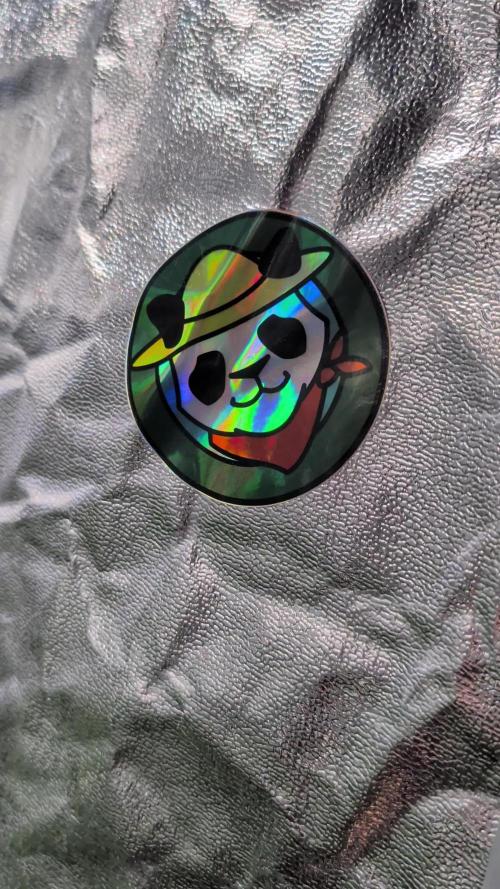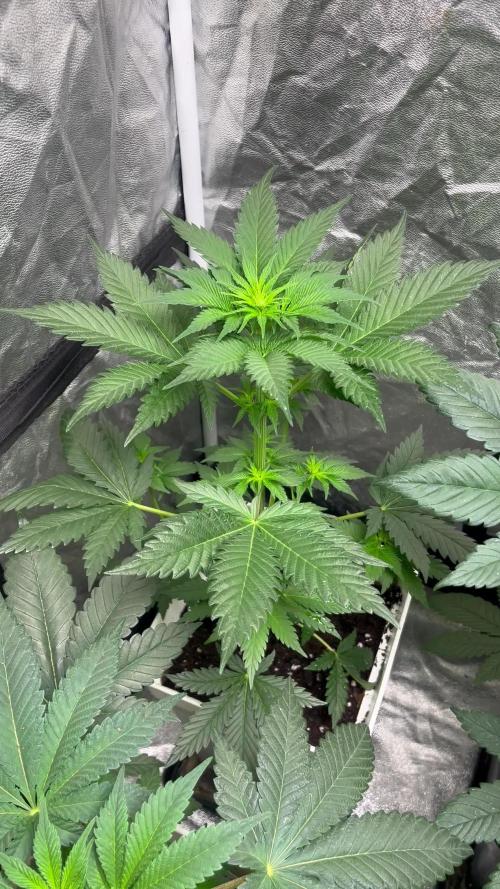The Grow Awards 2026 🏆 





























Likes
Comments
Share


@KcKush
Follow
*Looks like I missed one week and didn’t even notice.
*Didn't feed for the last week.
*Chopped it down one week early. Could of gone for more but need the space.
Likes
170
Share


@Hologram
Follow
its a dark and rainy morning but dont worry, it gets sunnier today!🙌
lemonade Runtz is in safehouse, almost being eaten alive, and torn apart by all the spiders(and other mofos), as u can c, but she does not give a F**k! 👊
(i have sprayed her with neemoil mix (neemoil and detergent with luke warm water) this week so i hope all the invaders will stay away a bit..)
she grew well this week, those lil holes in leaves will not kill her or her spirit !
😇👍
happy growing for all✊
Likes
52
Share


@DogDoctorOfficial
Follow
Things are getting dense and kind a wild 😜🤩😅 but all looking as it should 😊
They are stretching and with the colors we want for this fase, I’m trying to get to day 20/21 for mass defoliation, but if they keep growing like this i think sooner than that my hands will be all over them 😈😇 let’s see how they evolve and grow 😌
For now i’m keeping my vpd at 1.1kPa, my ppfd around 700 uMol/m2/s this gives me more or less a DLI of 27.72 , my Co2 is at 850ppm
5x White Mango
5x Alasken Purple
4x Blueberry
3x SAD S1
3x Badazz Cookies
10 in total for a 4x8x6 - 1,2x2,4x2
Light Lumatek Zeus 465W compact pro 2x at 100%
All i Grow is medicine for myself,
Stay safe, stay tuned and B Happy and do it for the love
Peace ✌️
D
Likes
7
Share


@brapzky
Follow
I figured nothing could go wrong with 50% amber / 50% milky trichomes.
Harvest day, Medical Mass: Huge buds and no traumas but got bud rot because of too high temps. The best I've ever smoked.
Harvest day, Pineapplex Express: Got an early trauma when transplanting but handled it beautifully. Potent smoke.
Pretty satisfied for a first grow, and I have a lot of changes for my 2nd grow!
Likes
48
Share


@Regenwurm
Follow
Temperatur und die Entwicklung läuft gut, die Ladies haben immer noch grossen Durst . Diese Woche die Damen 1 mal mit voller Düngedosis nach Plan von Green Buzz gegossen 1 mal nur angepasstes Wasser pH 6,2 und 2 mal halbe Düngemenge . Nachts ca 23 Grad/ Tags 26 Grad. Luftfeuchtigkeit bei relativ konstant 50%. Also Klima gut, ich komme aber trotz 2 Entfeuchtern nicht unter 50 % RLF.
Bei einer der Ladies habe ich einen Anteil von ca. 50 % Coco dort die doppelte Menge calmag wie oben bei dem Dünger angegeben . Die Blattfarbe der beiden Pflanzen ist sehr gut . PH Wert Gieß und Drain diese Woche nicht geprüft, blattfarbe ist gut nächste Woche wird normal bis leicht gegossen . Ec gemessen mit 2,2 heist nach Angabe Green buzz aktuell mit ca 1,1 ganz gut .Der Weg die Ladies austrocknen zu lassen und stark zu gießen hat sich bisher als gut erwiesen . Die Damen sehen beide gut aus. Keine Entlausung oder Training in dieser Woche . Lichtstärke der Lampe auf 92 % bei einem Abstand von 40 cm gelassen. Es ist interessant zu sehen wie sich die unterschiedlichen Medien Coco und Erde bei gleichem Dünger und gleichem Licht entwickeln
Likes
13
Share


@NanoLeaf
Follow
Overall very solid strain from Ethos as I expected. They definitely pushing the boundaries.
This strain is extremely pungent and smells like a bag of Skittles when you just open it. Wish I could turn it into an air freshener and smell it all day long.
Smoke is off the charts and very uplifting.
LOVE Ethos Zweet Auto!
Likes
9
Share


@Growtopus
Follow
Alle 3 sind enorm explodiert und größer geworden, das Pflanzengeflüster knallt richtig rein 👌🏻
Bei der Kontrolle sind mir ein paar Trauermücken aufgefallen, deshalb wurde eine neue Gelbtafeln reingehängt und mit Neudomück gegossen, um die Larven zu töten.
Durch gezieltes Entlauben wollen wir die drei schön buschig bekommen, wobei die Cookies and Cream jetzt schon sehr gleichmäßig und buschig wächst. Nächste Woche stellen wir definitiv auf Blüte um, da sollten alle 3 bereit sein und es passt gut mit den Anwendungen vom Pflanzengeflüster.
C&C und Seifuku erholen sich auch sehr gut vom Toppen und die neuen Triebe kommen gut.
Um die Temperatur zu halten, wurde die SANlight 20 % mehr aufgedreht, also sind wir jetzt bei 60 % bei 75 cm Abstand. Somit ist die Lichtleistung, die bei den Pflanzen ankommt, nur leicht höher als vorher, die Temperatur bleibt aber stabil über 21 ° C "tagsüber".
Processing
Likes
23
Share


@eldruida_lamota
Follow
Como estamos familia, a día de hoy, viernes, llevamos exactamente 7 días en la fase de floración y todas ellas están marcadas por su sexo.
Todo va sobre ruedas, tenemos mínimas de 20,5 y maximas de 28,5 grados. la humedad no supera nunca el 60%.
Altura mínima lemon kush 25cm.
Altura maxima northern light xl 42cm.
•las power plant xl Han pegado un estirón serio, están empezando a ensanchar bastante.
•una marea verde desde semilla, con tan solo 5 semanas de crecimiento y un solo trasplante desde que se germinó, para controlar un mal crecimiento.
Processing
Likes
7
Share


@Mr_nugs_lover_David
Follow
This ladies look absolutely gorgeous and super strong, they're gonna be flipped into flower tomorrow on February 15th when they'll hit the 30th day since they were planted and the first day of flower!
As said, I have flipped this ladies into flower on February 15th so now I think we're gonna see a beautiful stretch specially on this 2 plants which are the biggest one in the tent, very nice genetic, cannot wait to see their performance ❤️💛💚👨🌾 stay tuned everybody! This is gonna be a beautiful run! ✌️
Processing
Likes
Comments
Share


@Hampoop35
Follow
This strain is still new to me. It seems like it’s starting to flower! Golden leaf! It’s been super easy to grow so far!!
Likes
55
Share


@Max1973
Follow
Day 57 - The girls are bursting with flower....... looked abit light (the main tops looked a light green, showed signs of nutrient deficiencies), so upped the Dutch Master Gold One Flower, it's 1000 ppm now.... thinking about Defoliation... outside temperatures are middle of winter, 0oC to 20oC (32oF to 70oF) .... but typical high low is 5-15oC (40-60oF)......... surprisingly the LED's warm the tent upto 20-24oC,
this is important point.... i am running the lights, 6 pm to 6 am... 12hrs lights on all night, and all day is night mode...... during the day is the highest temps of the day... and during the lowest temps, they have the light heat .......
Day 61 - I trimmed em .... this was the third defoliation..... things are starting to get sticky..... ah i'm just going to wing it.... they are 2 months (8 wks) from seed.... idk what i'm doing.......
i did some serious stress bending today, and had to put afew tie downs in..... my theory is to hurt em as much as i can without killin em....
to make em harder, stronger, faster, more stressed, so they can survive anything..... grow em stronger......
the smell is zero in the home, but once i got them out for their 2 week haircut, they started producing some strong wet kisses, that were sticky and wet.... the
aroma of heavenly ladies was abundant...... 😎😎
idk... this tastes so good.... it's like some kind of weird berry combo goodness.... i'm vaping vanilla custard atm and this is so good with vanilla custard.... vanilla custard kush n cookies... haha
watch the video......... 😎
Likes
13
Share


@DieselKush
Follow
Oct.29 - We transplanted the girls into soil since they are moving into vegetation phase
Nov.4 - Watered each plant 250mL, 0.25mL of each nutrient for each girl
Likes
13
Share


@Silverback_Guerilla
Follow
1/14:
Fed today. The Cheese is getting fat and reeking with a funky odor! The Zkittlez and Bubbleguns are fattening nicely as well, but they smell more like candy.
1/18:
Fed today and rearranged. Increased UVB exposure by another 30 mins per day
1/21:
Fed today.
Likes
4
Share


@eldruida_lamota
Follow
Que hay familia, vamos con la primera semana de floración de estas Runtz de Zamnesia.
Utilizo la tierra de plagron lightmix que siempre utilizo, controlando siempre el Ph, que ahora mismo lo dejamos en 6.
Temperatura y humedad dentro de los parámetros correctos.
Seleccioné de las 5 plantas, 3 , que creo que son los mejores ejemplares que por el momento están creciendo bien y tener tienen un buen color, se ven bien sanas, todo normal hasta ahora, ya marcaron preflores.
Vamos viendo cómo progresan. Hasta aquí todo, buenos humos 💨💨💨.
Likes
63
Share


@Krisis
Follow
07/23/24. Going into week 4 flower
After last update, the things I mentioned worsened. The yellowing turned pasty and almost whitish. The leaves feel weird.. like thick and not rubbery.. but kinda. Don’t know how to describe it.
I had stopped feeding her, other than calmag with micros, one of which is iron. I had also backed the light off since she also appeared burned on the buds or something.
Wasn’t noticing much improvement so I checked runoff and it was very acidic. I then over a few hours time gave her large amounts of water until it got more clear when it came out. After that I finished off with just the calmag/iron.
A few hours later her leaves were perked up. They still looked bad obviously not going to change that fast.
Jumping to today, parts of the leaves look to be regaining some green, especially in the veins and in toward the bases, which is where the most white/yellow was. The buds are starting to grow again, but still appear burnt and lacking hairs. With the green returning..if you look now the symptoms would say nutrient burn. I’m not an expert, but I’m unaware of nutrient burn turning a plant white and yellow and being able to regain green after? If I’m wrong on that please let me know.
For now I am going to just keep going on with water silica and calmag OAC as it seems to be at least doing something that looks right. I also feel the lights way too dimmed (50% 22in) and high, but not taking chances. I’d rather have the plant healthy vs killing her for bud size.
Hopefully too much damage hasn’t been done and my once beautiful Pablita will once again be. 😿
Update: 07/26/24
More whiteness/pasty has decreased and a few little hairs have sprouted! This seems like progress. As green gradually reappears on top.. it’s disappearing in other spots.































